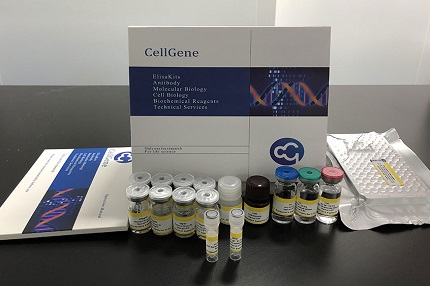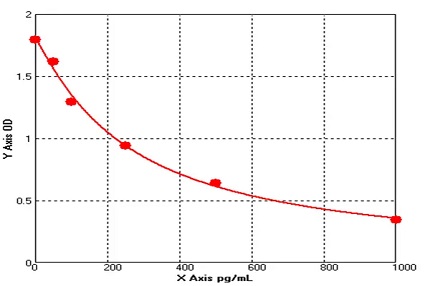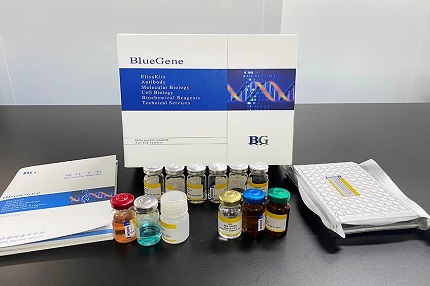E02H0029 Rat Hyaluronic Acid ELISA kit
The Rat Hyaluronic Acid ELISA kit can be used to identify samples from the rat species. Hyaluronic Acid can also be called HA, hyaluronan, Hyaluronan, Hyaluronate.


E02H0029 Rat Hyaluronic Acid ELISA kit
The Rat Hyaluronic Acid ELISA kit can be used to identify samples from the rat species. Hyaluronic Acid can also be called HA, hyaluronan, Hyaluronan, Hyaluronate.
Product Information | |
Cat. No. | E02H0029 |
Product Name | Rat Hyaluronic Acid ELISA kit |
Species | Rat |
Product Size | 48 Tests / 96 Tests |
Concentration | 10-250 ng/mL |
Sensitivity | 1.0 ng/ml |
Principal | Competitive ELISA |
Sample Volume | 100 ul |
Sample Type | Serum, plasma, cell culture supernatants, body fluid and tissue homogenate |
Assay Time | 90 minutes |
Platform | Microplate Reader |
Conjugate | HRP |
Detection Method | Colorimetric |
Storage | 2-8°C |
Kit Components | ||
MATERIALS | SPECIFICATION | QUANTITY |
MICROTITER PLATE | 96 wells | stripwell |
ENZYME CONJUGATE | 6.0 mL | 1 vial |
STANDARD A (0.5mL) | 0 ng/mL | 1 vial |
STANDARD B (0.5mL) | 10 ng/mL | 1 vial |
STANDARD C (0.5mL) | 25 ng/mL | 1 vial |
STANDARD D (0.5mL) | 50 ng/mL | 1 vial |
STANDARD E (0.5mL) | 100 ng/mL | 1 vial |
STANDARD F (0.5mL) | 250 ng/mL | 1 vial |
SUBSTRATE A | 6 mL | 1 vial |
SUBSTRATE B | 6 mL | 1 vial |
STOP SOLUTION | 6 mL | 1 vial |
WASH SOLUTION (100 x) | 10 mL | 1 vial |
BALANCE SOLUTION | 3 mL | 1 vial |
Principle of the Assay |
HA ELISA kit uses an anti-HA antibody and an HA-HRP conjugate in a competitive enzyme immunoassay method. HA-HRP conjugate is incubated with the assay sample and buffer in a pre-coated plate for one hour. The wells are decanted and washed five times when the incubation period is over. The HRP enzyme substrate is then incubated in the wells. The result of the enzyme-substrate reaction is a complex that is blue in hue. The process is finally stopped by adding a stop solution, causing the solution to turn yellow. In a microplate reader, the color intensity is measured spectrophotometrically at 450 nm. Due to competition for the anti-HA antibody binding site between HA from samples and HA-HRP conjugate, the intensity of the color is inversely proportional to the concentration of HA. Since the number of sites is limited, as more sites are occupied by HA from the sample, fewer sites are left to bind HA-HRP conjugate. A standard curve is plotted relating the intensity of the color (O.D.) to the concentration of standards. The HA concentration in each sample is interpolated from this standard curve. |
Coefficient of Variance | Intra Variation% <10% | |
Inter Variation% <12% | ||
Recovery | 95-102% | |
Linearity | Diluent Ratio | Range % |
1:2 | 93-105 | |
1:4 | 88-106 | |
1:8 | 86-108 | |
Specificity/Cross-reactivity | No significant cross-reactivity or interference between HA and analogues was observed. | |




E02H0029 has been referenced in the below publications:
Adipose tissue-derived stem cells ameliorate hyperglycemia, insulin resistance and liver fibrosis in the type 2 diabetic rats.
Inhibitory effect of paclitaxel on hepatic fibrosis in rats and its mechanism.
Studies on functional effect and mechanisms of anti-alcohol and liver-protection of Lingzhisuan Granule.
The Role of Hyaluronic Acid and CD44 during the Airway remodeling in Chronic Asthma.
Protection against nonalcoholic steatohepatitis through targeting IL-18 and IL-1alpha by luteolin.
Modified citrus pectin stops progression of liver fibrosis by inhibiting galectin-3 and inducing apoptosis of stellate cells.
Antifibrotic effect of AT-1 blocker and statin in rats with hepatic fibrosis.
Tracking anti-fibrotic pathways of nilotinib and imatinib in experimentally induced liver fibrosis: An insight.
Related Bluegene Biotech Products



